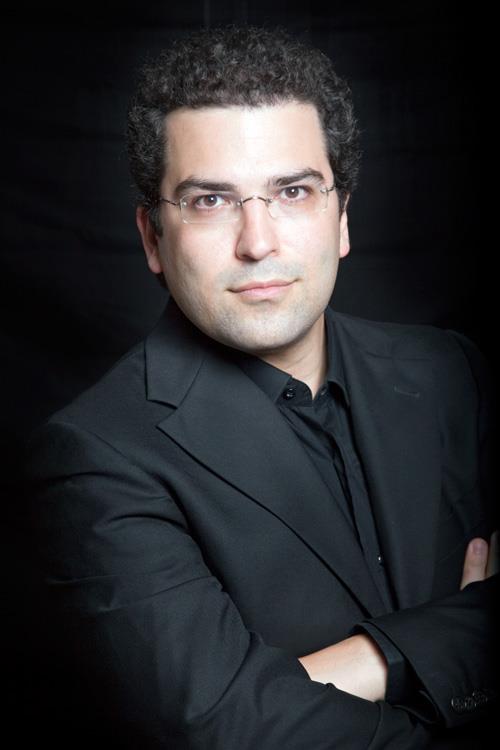2012
April 12, 2012 | Review on MusicalAmerica
Marcello Di Lisa
"the new artist of the month"
When the conductor is a scholar
by Carlo Vitali
The first time I came across Marcello Di Lisa’s name was in 2010, while reviewing some CDs for the 350th anniversary of Alessandro Scarlatti’s birth. A compilation of rare sacred works on the German label CPO was followed by an even more impressive anthology of operatic arias and ouvertures, most of them premiere recordings, issued on Deutsche Harmonia Mundi. What struck me at first sight was the combination of starry Baroque vocalists (such as Gemma Bertagnolli, Sara Mingardo and Daniela Barcellona) with a whoolly obscure conductor and his period band Concerto de’ Cavalieri, meaning: concert of knights.
Which knights, I wondered. After a brief investigation, I discovered that the intended reference was to the knightly order of Santo Stefano at Pisa, founded in 1561 by the Medici Grand Duke of Tuscany. Besides fighting the Turkish fleets in the Mediterranean, those proud white-cloaked warriors ran a music chapel attached to their church as a place to celebrate their military victories. The present Concerto de’ Cavalieri has not much in common with its historic namesake, other than the fact that founder and Rome-based harpsichordist Marcello Di Lisa is an alumnus of the University of Pisa.
The present Concerto de’ Cavalieri has not much in common with its historic namesake, other than the fact that founder and Rome-based harpsichordist Marcello Di Lisa is an alumnus of the University of Pisa.
I met Marcello, a debonair gentleman in his early 30s, at his home in downtown Rome. Only with gentle urging was he comfortable talking about himself. He recounted how, as a piano student raised in a music-loving family, he was always aware of the spell of ancient civilizations. After training in Latin and Greek in high school, he enrolled at the ancient University of Pisa, where Galileo used to teach mathematics in the 1590s. “It was a city I fell in love with on my very first visit. There I met [classical scholar] Professor Antonio Carlini, under whose tutorship I obtained a doctorate with a dissertation about the works of the Greek scientist Archimedes. This may sound like dreary stuff for non-specialists,” he says, fully aware that the interpretation of papyrus fragments from the archaeological foils at Herculaneum by Naples is probably less exciting than the adventures of Indiana Jones. Nonetheless, Marcello was drawn to researching the sources of ancient wisdom, particularly maths.
After numerous of his essays were published in major scholarly journals, Di Lisa’s future academic path seemed assured. But then music came to rescue. Franco Conti, a teacher of physics at the elite college (at the University of Pisa) called Scuola Normale Superiore, was a connoisseur of early music, as well as the overseer of extracurricular activities at the university. Di Lisa looks back in gratitude to his Alma Mater for offering him a rare opportunity: “Professor Conti encouraged me to practice on a precious harpsichord kept in the former palace of the Knights of Pisa, now one of the University buildings. With a group of fellow students, I formed an ensemble and started giving concerts. Nothing very professional, I’m afraid.”
The promising young scholar kept enriching his training in performance practice on the harpsichord and the fortepiano, largely with tuition support from the likes of conductor and musicologist Ottaviano Tenerani in Pisa and harpsichordist Andrea Coen in Rome. As he began to grow into a full-fledged musician, expanding into musicology and composition in school, Di Lisa came to have doubts about his earlier stated vocation. After long reflection, he resolved to dedicate himself entirely to music.
That did not, however, preclude using the research training he had had in academia. “Music – early music even more so – is written down as a text which needs to be understood in its structural and formal elements,” he says, “then brought to life through a deep understanding of unwritten conventions such as phrasing, ornaments, continuo.”
Both on record and in live performance, the Concerto de’ Cavalieri does credit to Marcello’s scientific approach. Compared with the wanton fury and the morose languors of several period bands, its technically sterling musicianship has a refreshing clarity, without any loss of rhythmic liberty. It has vigor, thrust and eloquence. To quote a reviewer’s recent summation of the Scarlatti operatic compilation, “the last time I heard playing this spirited from an Italian periodinstrument orchestra was probably on one of Il Giardino Armonico’s CDs. But Concerto de’ Cavalieri is ever so much more refined...”
Reminded of the review, Di Lisa smiles meekly and explains that the CD was the first instalment of a multi-year project on Italian 18th-century opera for Sony Classical, the second volume of which, on Pergolesi, is soon to be issued. “At present, I’m researching the Vivaldi manuscript sources in Turin for a concert-cum-recording project in the works. Of course we are looking forward to expanding our repertoire, to Mozart and beyond.”
Last fall, I heard Marcello conduct live in Naples at the world modern premiere (produced by the Centro Pietà dei Turchini, recently parted from their mercurial director Antonio Florio) of “Erminia”, a 1723 wedding serenata by Scarlatti and arguably his last dramatic work.
Leading from the harpsichord, Di Lisa flawlessly negotiated the fiendishly difficult vocal parts and the complexities of a particularly rich orchestral scoring. This young man seems poised for great accomplishments in the field of Baroque music. So much the worse for Greek scholarship, though.
Carlo Vitali
